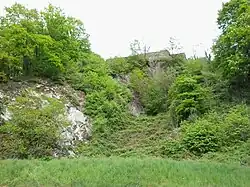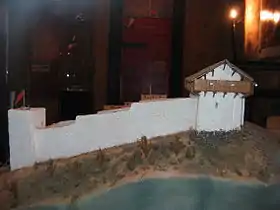Castle of the fairies
The château des fées, château défait or château du Waridon is a medieval fortress whose ruins lie on the upper Meuse near Le Waridon in the commune of Montcy-Notre-Dame) of the Ardennes. Its origins date back to between the 9th and 16th centuries.
| Castle of the fairies | |
|---|---|
Château défait, or Château du Waridon | |
| Montcy-Notre-Dame, Ardennes in France | |
 | |
 Castle of the fairies | |
| Coordinates | 49°46′32″N 4°44′37″E |
| Type | Castle |
| Site information | |
| Condition | Ruined |
| Site history | |
| Built | 9th or 11th century to 16th century |
This castle seems to have inspired the château d'Oridon mentioned in various manuscripts and chansons de geste, as well as the château de Montessor in The Four Sons of Aymon.[1]
Location
The ruins of this ancient fortress sit on a rocky crag overlooking the Meuse and the Charleville-Mézières neighborhood of Montcy-Saint-Pierre.
History

Construction of the fortress first began in 870, when the Meuse became a border between successor states of the former Carolingian Empire with the Treaty of Meerssen.
Excavations have uncovered strata with traces of a conflagration at the end of the 10th or the beginning of the 11th century, as dated by coins discovered in the castle keep and outside the fortress walls.
The stone building, the window lead, the very carnivorous diet [lower-alpha 1] speak to the importance of the stewards.[3] At the time, wood was a necessity.
The castle's name at the time is unknown. The name "château des fées" dates back to 1020, no doubt the date of its destruction by the troops of the Roman Catholic Archdiocese of Reims.[4] While legends surrounded the place for centuries, it seems that the name château des fées was a corruption of château défait (ruined castle).
At the beginning of the 16th century the castle was rebuilt by François d’Aspremont, who made it his home. This fort, along with that of Château de Lumes, allowed him to control the riverways to Charleville and to extract ransom from both ships and travellers. He allied himself with Charles Quint, who was interested by the strategic locations of d'Aspremont's domains. D'Aspremont agreed to give hommage to one of Charles Quint"s vassals, the grand bailli de Hainaut. Francis I of France banned and destituted d'Aspremont in 1534, but he held out against royal troops until 1542, pillaging the region. He was forced to flee in 1542.[5]
In 1629, the fortress of Woiru (Woiridon) was attested as destroyed.
Excavations
Excavations have uncovered a dry-stone wall, suggesting a rectangular building of 18 × 10 meters.
These excavations indicate the following chronology:
- a primitive rectangular building, constructed of perishable materials, since post holes have been discovered;
- a large rectangular tower of herringbone masonry followed. Its foundations were cut from the rock, then additions were built on the east and west;
- destruction by fire in the 11th century, as dated by two silver deniers and an obole;
- rebuilding in the 16th century.
Archeological finds are kept at the musée de l'Ardenne and include lead from the windows, glassware, coins, arrowheads, crossbow quarrels, deadbolts, grain, pottery, and bone fragments from game animals.
Literature and chansons de geste
The castle may have inspired the legendary Montessor, the fortress of The Four Sons of Aymon in the Ardennes, named after Renaud de Montauban. At least, Prosper Tarbé in 1861 tentatively identified the legendary fortress as the château de Waridon in Montcy-Notre-Dame.[6]
As well, a château d'Oridon, "a very tall tower atop a rocky crag in the Ardenne forest", is mentioned in several medieval epic poems: its description and other associated details seem to coincide with the château du Waridon.[7][8]
 Excavation finds donated to the musée de l'Ardenne.
Excavation finds donated to the musée de l'Ardenne. Carved bones found in excavations.
Carved bones found in excavations.
Notes
- The excavation of a rectangular building destroyed in a fire in the beginning of the 11th century found that the kitchen trash primarily consisted of scraps from game animals[2]
References
Citations
- International Commission for the History of Representative and Parliamentary Institutions. Section belge (1963). "Standen en landen".
- Nicolas Mengus (2021). Châteaux forts au Moyen Âge. Rennes: Éditions Ouest-France. p. 236. ISBN 978-2-7373-8461-5..
- Nicolas 2006, p. 28.
- Benkemoun 1999.
- La Bare de Raillicourt 1987, p. 215.
- Lejeune 1963, p. 68.
- Rousseau 1943, p. 651.
- Pierret 1937, p. 25-26.
Bibliography
- Benkemoun, Brigitte (18 November 1999). "Le nouveau seigneur du château des Fées" [The new lord of the castle of the fairies]. L'Express.
- Boulliot, Jean-Baptiste-Joseph (1830). "Aspremont (François D')". Biographie Ardennaise ou Histoire des ardennais qui se sont fait remarquer ... Paris: Chez l'éditeur rue de l'Arbre-Sec n°9 et chez Ledoyen, librairie, Palais Royal, Galerie d’Orléans, n°33.
- Diot, Nathalie (21 September 2011). "Patrimoine: le château des fées sous la loupe de chercheurs européens" [Heritage: The castle of the fairies under the magnifying glass of European researchers]. L'Union.
- La Bare de Raillicourt, Dominique de (1987). "Lumes". Revue Historique Ardennaise. XXII: 207–228.
- Lejeune, Rita (1963). L'Ardenne dans la Littérature Médiévale [Ardennes in Medieval Literature]. pp. 42–80.
{{cite book}}:|work=ignored (help) - Nicolas, David (2006). "L'archéologie des boucles de la Meuse autour de Charleville-Mézières". Revue Historique Ardennaise. Société d'Histoire des Ardennes (38): 7–34.
- Pierret, Albert (April 1937). "Le Château d'Oridon" [The castle of Oridon]. La Grive,revue ardennaise de littérature et d'art (in French). Société des écrivains Ardennais: 25–26.
- Rousseau, Felix (1943). "Albert Pierret (1895-1942)". Revue belge de Philologie et d'Histoire. 22 (1): 648–651.